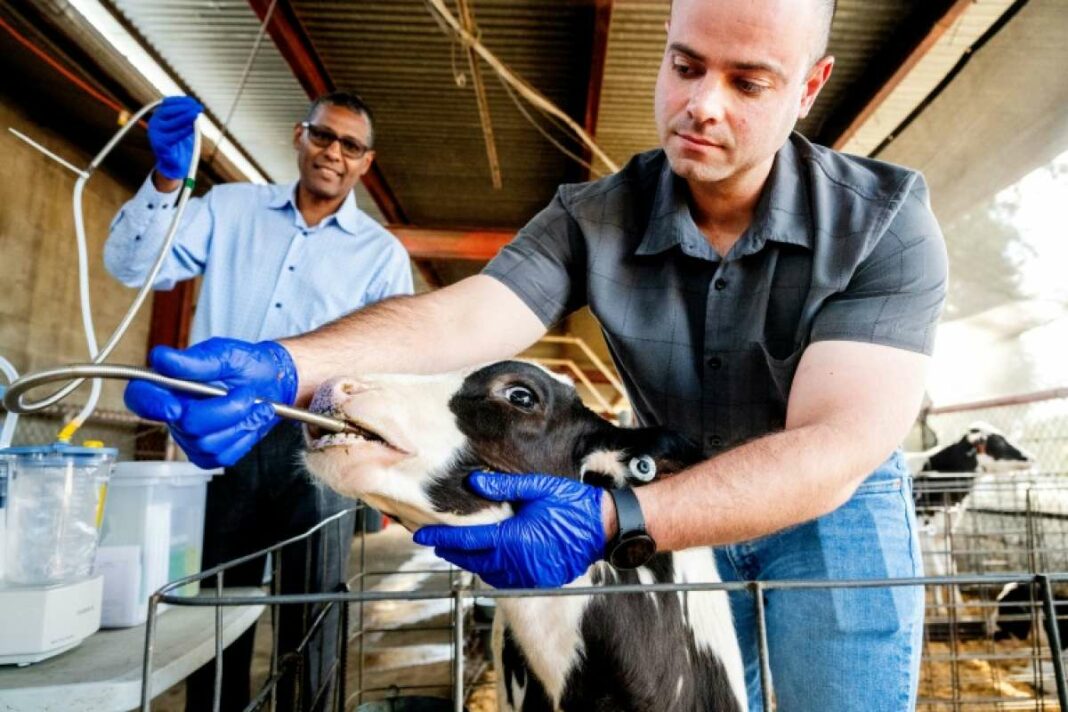Paulo de Méo Filho, a Brazilian researcher at UC Davis, is experimenting with a technique involving a tube in a calf’s mouth to analyze gut microbiomes and reduce methane emissions from cattle. This project, part of a collaboration with the Innovative Genomics Institute, aims to develop a pill that incorporates genetically modified microbes and algae in cattle diets. With a budget of $70 million over seven years, the initiative seeks to enhance livestock productivity while addressing climate change challenges.
Transforming Cow Microbiomes for a Greener Future
In an innovative experiment aimed at reducing greenhouse gas emissions, Paulo de Méo Filho, a Brazilian postdoctoral researcher at UC Davis University in Northern California, is utilizing a unique technique involving a long tube inserted into the mouth of a two-month-old calf, affectionately named ‘Thing 1’. This method is part of a broader initiative to develop a groundbreaking pill that could significantly diminish methane emissions produced by cattle.
As methane is a potent greenhouse gas, contributing to nearly half of the temperature increase since the industrial era, the importance of this research cannot be understated. “Cows are a major source of methane emissions, which poses a challenge for large-scale agriculture and climate change,” notes Ermias Kebreab, a professor of animal science, while Thing 1 playfully attempts to lick his hand.
A Collaborative Effort for Sustainable Agriculture
The project involves a dedicated team of around 40 individuals, collaborating between UC Davis and the Innovative Genomics Institute at Berkeley University. Notably, the co-founder of the institute, Jennifer Doudna, was awarded the Nobel Prize in Chemistry for her pioneering work in CRISPR gene editing, which is fundamental to this research.
The tube used on Thing 1 serves a critical purpose: it extracts liquid from the calf’s rumen, the primary chamber in a ruminant’s digestive system, where food undergoes initial digestion. By analyzing these samples, researchers can gain insights into the gut microbiome of cows, particularly the microbes responsible for converting hydrogen into methane. This is crucial, as a single cow can regurgitate approximately 100 kg of methane annually.
To address this issue, the calves, including Thing 1 and his brother Thing 2, are being fed a diet that includes algae, a natural deterrent to methane production. Scientists are exploring the introduction of genetically modified microbes designed to capture hydrogen, thereby limiting the resources available to methane-producing organisms.
However, the research team remains cautious about potential side effects that could arise from these modifications. “If we inhibit methanogenesis, there is a risk that hydrogen could build up and become harmful to the animal,” warns Matthias Hess, a microbiology professor overseeing related lab work.
As the team conducts experiments in bioreactors that simulate the conditions within a ruminant’s stomach, they are optimistic about finding the right microbial candidate to genetically alter. The goal is not only to reduce methane emissions but also to enhance the productivity of the cows. “If we can redirect hydrogen and methane as energy sources, we can create a more productive and less polluting livestock,” Kebreab explains.
Ultimately, the researchers aim to create a single administration method, such as a pill or injection, to ensure the cows benefit from these modifications without the need for daily treatment. With a budget of 70 million dollars and a seven-year timeline, the project holds significant promise, despite the inherent challenges.
In conclusion, Kebreab emphasizes the uniqueness of this endeavor, stating, “This is a high-potential project unlike any other.” He advocates for sustainable livestock farming methods and remains committed to improving food production in developing countries, where meat consumption remains essential for nutrition.
